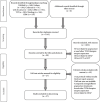Investigating Prescriptions and Mechanisms of Acupuncture for Chronic Stable Angina Pectoris: An Association Rule Mining and Network Analysis Study
- PMID: 33110434
- PMCID: PMC7578734
- DOI: 10.1155/2020/1931839
Investigating Prescriptions and Mechanisms of Acupuncture for Chronic Stable Angina Pectoris: An Association Rule Mining and Network Analysis Study
Abstract
Chronic stable angina pectoris (CSAP) is a worldwide cardiovascular disease that severely affects people's quality of life and causes serious cardiovascular accidents. Although acupuncture had been confirmed as a potential adjunctive treatment for CSAP, the basic rules and mechanisms of acupoints were little understood. We conducted a systematic search of the China Biology Medicine (CBM), VIP database, Wangfang database, China National Knowledge Infrastructure (CNKI), PubMed, Cochrane Library, Embase, and Web of Science to identify eligible clinical controlled trials (CCTs) and randomized controlled trials (RCTs), from their inception to 18th February 2020. The acupoint prescriptions in the treatment of CSAP were extracted and analyzed based on the association rule mining (ARM) and network analysis. In addition, potential mechanisms of acupuncture for treating CSAP were summarized by data mining. A total of 27 eligible trials were included. Analysis of acupoint prescriptions covered 36 conventional acupoints and 1 experience acupoint, distributing in 10 meridians. The top three frequently used acupoints were PC6, LU9, and ST36. The top three frequently used meridians were the pericardial meridian, lung meridian, and heart meridian. The most frequently used acupoint combinations were LU9 combined with PC6. Besides, network analysis indicated that the core acupoints included PC6, BL15, ST40, and RN17. Moreover, potential mechanisms of acupuncture for treating CSAP involved the regulation of autonomic nerve function, the content of matrix metalloproteinase-9 (MMP-9), volume and the equivalent block of coronary artery calcified plaque (CACP), endothelin (ET), and nitric oxide (NO), neutrophil-lymphocyte ratio (NLR), the content of C-reactive protein (CRP), and tumor necrosis factor-α (TNF-α). In conclusion, our findings concerning acupoint prescriptions and potential mechanisms in the acupuncture treatment of CSAP could provide an optimized acupuncture treatment plan for clinical treatment of CSAP and promote further mechanism research and network research of CSAP.
Copyright © 2020 Jie Yu et al.
Conflict of interest statement
The authors declare that they have no conflicts of interest.
Figures






Similar articles
-
Analysis of acupoint selection and prescription rules of acupuncture for treatment of stable angina pectoris based on a Traditional Chinese Medicine inheritance calculation platform: A systematic review.Medicine (Baltimore). 2022 Dec 9;101(49):e31466. doi: 10.1097/MD.0000000000031466. Medicine (Baltimore). 2022. PMID: 36626434 Free PMC article.
-
Investigating Acupoint Selection and Combinations of Acupuncture for Tic Disorders: An Association Rule Mining and Network Analysis Study.Front Neurol. 2022 Jun 10;13:894951. doi: 10.3389/fneur.2022.894951. eCollection 2022. Front Neurol. 2022. PMID: 35756940 Free PMC article.
-
[Regularities of acupoint combinations and characteristics of core acupoint application for acupuncture-moxibustion treatment of mammary gland hyperplasia based on complex network analysis].Zhen Ci Yan Jiu. 2021 Jan 25;46(1):76-83. doi: 10.13702/j.1000-0607.200696. Zhen Ci Yan Jiu. 2021. PMID: 33559431 Review. Chinese.
-
Acupuncture for chronic, stable angina pectoris and an investigation of the characteristics of acupoint specificity: study protocol for a multicenter randomized controlled trial.Trials. 2014 Feb 5;15:50. doi: 10.1186/1745-6215-15-50. Trials. 2014. PMID: 24499445 Free PMC article. Clinical Trial.
-
[Acupoints compatibility rules of acupuncture for depression disease based on data mining technology].Zhongguo Zhen Jiu. 2023 Mar 12;43(3):269-76. doi: 10.13703/j.0255-2930.20221103-k0001. Zhongguo Zhen Jiu. 2023. PMID: 36858387 Chinese.
Cited by
-
The Mining Algorithm of Maximum Frequent Itemsets Based on Frequent Pattern Tree.Comput Intell Neurosci. 2022 May 18;2022:7022168. doi: 10.1155/2022/7022168. eCollection 2022. Comput Intell Neurosci. 2022. PMID: 35634074 Free PMC article.
-
Exploring the potential of acupuncture practice education using artificial intelligence.Integr Med Res. 2025 Mar;14(1):101123. doi: 10.1016/j.imr.2025.101123. Epub 2025 Jan 23. Integr Med Res. 2025. PMID: 39944111 Free PMC article. Review.
-
Acupuncture indication knowledge bases: meridian entity recognition and classification based on ACUBERT.Database (Oxford). 2024 Aug 30;2024:baae083. doi: 10.1093/database/baae083. Database (Oxford). 2024. PMID: 39213389 Free PMC article.
-
Acupuncture and related therapies for stable angina pectoris: A protocol for network meta-analysis.Medicine (Baltimore). 2020 Dec 18;99(51):e23756. doi: 10.1097/MD.0000000000023756. Medicine (Baltimore). 2020. PMID: 33371136 Free PMC article.
-
A decision support system for upper limb rehabilitation robot based on hybrid reasoning with RBR and CBR.Front Bioeng Biotechnol. 2024 Apr 24;12:1400912. doi: 10.3389/fbioe.2024.1400912. eCollection 2024. Front Bioeng Biotechnol. 2024. PMID: 38720881 Free PMC article.
References
-
- Task Force M., Montalescot G., Sechtem U., et al. 2013 ESC guidelines on the management of stable coronary artery disease: the Task Force on the management of stable coronary artery disease of the European Society of Cardiology. European Heart Journal. 2013;34(38):2949–3003. doi: 10.1093/eurheartj/eht296. - DOI - PubMed
-
- Fox K., Garcia M. A., Ardissino D., et al. Guidelines on the management of stable angina pectoris: executive summary: the task force on the management of stable Angina pectoris of the European society of Cardiology. European Heart Journal. 2006;27(11):1341–1381. doi: 10.1093/eurheartj/ehl258. - DOI - PubMed
-
- Haybar H., Javid A. Z., Haghighizadeh M. H., Valizadeh E., Mohaghegh S. M., Mohammadzadeh A. The effects of Melissa officinalis supplementation on depression, anxiety, stress, and sleep disorder in patients with chronic stable angina. Clinical Nutrition ESPEN. 2018;26:47–52. doi: 10.1016/j.clnesp.2018.04.015. - DOI - PubMed
LinkOut - more resources
Full Text Sources
Research Materials
Miscellaneous

